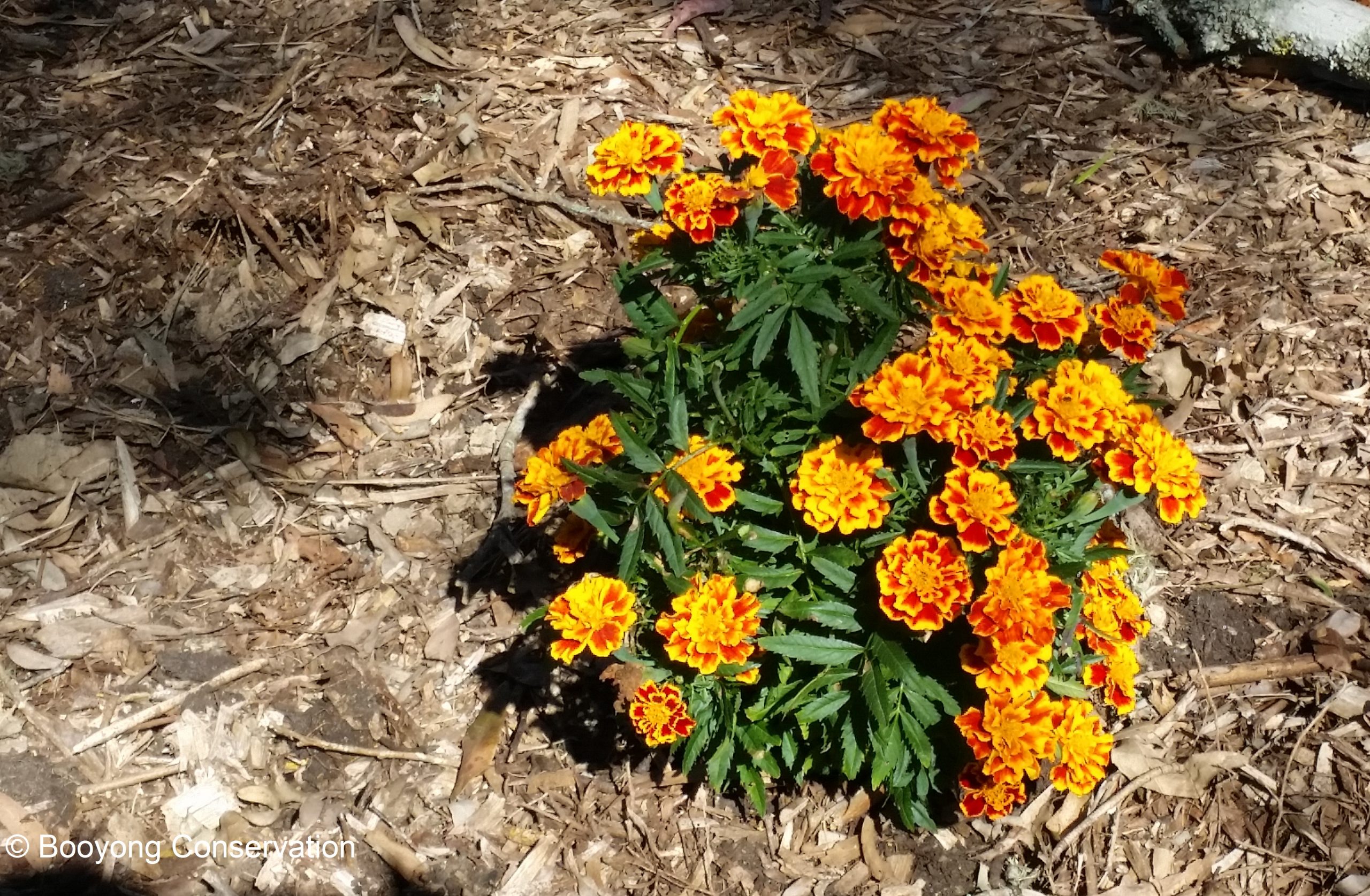Marigolds are an annual plant, other than the Marigold Tagetes Lucida which is a Perennial. There are a large variety of tall and dwarf Marigolds available and petal colours include, yellow, red and orange, as well as pastel shades. They grow in most areas of Australia excluding the tropical regions and are fantastic scattered amongst your gardens.
Types of Marigold we have at Booyong
 Marigold Tagetes patula which is also known as the dwarf french marigold and comes in orange, yellow, reddish brown and recently a white vanilla. These small plants (12-45 cm) flower profusely. They tolerate poor soil, heat, humidity and drought, growing and producing seeds in just one season. Even though dwarf marigolds are very adaptable, they do not like shady areas or waterlogged soil.
Marigold Tagetes patula which is also known as the dwarf french marigold and comes in orange, yellow, reddish brown and recently a white vanilla. These small plants (12-45 cm) flower profusely. They tolerate poor soil, heat, humidity and drought, growing and producing seeds in just one season. Even though dwarf marigolds are very adaptable, they do not like shady areas or waterlogged soil.
Marigold Tagetes lucida is commonly called the ‘Mexican tarragon’ or ‘Mexican Marigold’. A perennial that will reach about 1m in height and has lovely yellow flowers. The seeds from this plant were provided by our friend Francey. Similarly, to other Marigolds, this plant is drought tolerant however does not do well in frost.
Growing – Marigolds grow in most Australian climates. I have to say I have tried to grow marigolds from seed for a couple of years now, despite them being

considered easy to grow. I have been so happy to have success at Booyong this year and was delighted when I discovered Bob has also successfully planted some in the garden bed near the shack.
According to Jackie French’s guide to companion planting, thickly planted marigolds will create a barrier for grass at the edge of your veggie patch and we will do this at the edge of the herb spiral at Booyong. In addition, we will scatter them throughout the food forest.
Care – Marigolds like a sunny position in fertile and well-drained soil. Tall varieties should be placed 40cm’s apart and dwarf varieties 20cm. Water well and mulch well as they have a shallow root system, particularly during hot spells. Be sure to weed also to reduce plants competing for nutrients and remove spent blooms to prolong the flower display.
Pruning – Marigold Tagetes lucida – Cut back late in Winter.
Companion Planting – According to Jackie French (Jackie French’s guide to companion planting) marigolds protect cauliflowers, cabbages and brassicas from root-knot nematodes. The leaves of the marigolds can disguise the scent of plants from pests and the bright flowers can stop pests flying over them.
Surrounding the crop with a hedge of marigolds is more effective than a single plant and they will also attract beneficial bees and butterflies to your garden.
In the book Companion plants (Helen Philbrick and Richard Gregg) states marigolds contest potato nematodes and French marigolds cure white fly in tomatoes and are commonly used in green houses.
Pests and Diseases – Marigolds are susceptible to rust and can be managed by spraying with fungicide and removing severely affected plants. As we don’t use pesticides, we would remove the plants should this occur.
Marigold foliage is successfully used as an insect repellent.
Harvest – Marigolds flower from Spring through to Summer and Autumn. Mass flowers make a lovely cut flower display and if you dead head plants you will extend the flowering season.
Propagation – Marigolds can be grown from readily available seeds (sown in autumn and spring) and if they are planted in a warm position, germination takes around 1 – 2 weeks. Please feel free to let us know if you’d like some seeds.
Eating – All Marigold flowers are edible if grown organically and without pesticides.
Add the flowers to Ice cubes and freeze to add to drinks in Summer toss them in a salad or add them to cakes and deserts.
Marigold Tagetes lucida – is a plant that is used for medicinal and religious purposes. It is used as a tarragon substitute as well as for making herbal teas. The leaves have an aniseed flavour and it is also used in salads and as a garnish for fruit salads.
Marigold Butter Recipe – We love Flavoured butters (Nasturtium Butter is lovely too), they are easy to make and very handy to have in the freezer. To make them you first soften the butter, remove petals from the Marigolds and chop them, stirring them into the softened butter. Garlic, chill or ginger can be added along with parsley or coriander. Roll in glad wrap and place in freezer for use. Great on steaks, fish, chicken or placed over roasted vegetables.
Marigold Vinaigrette Recipe – Better Homes and Gardens

You must be logged in to post a comment.